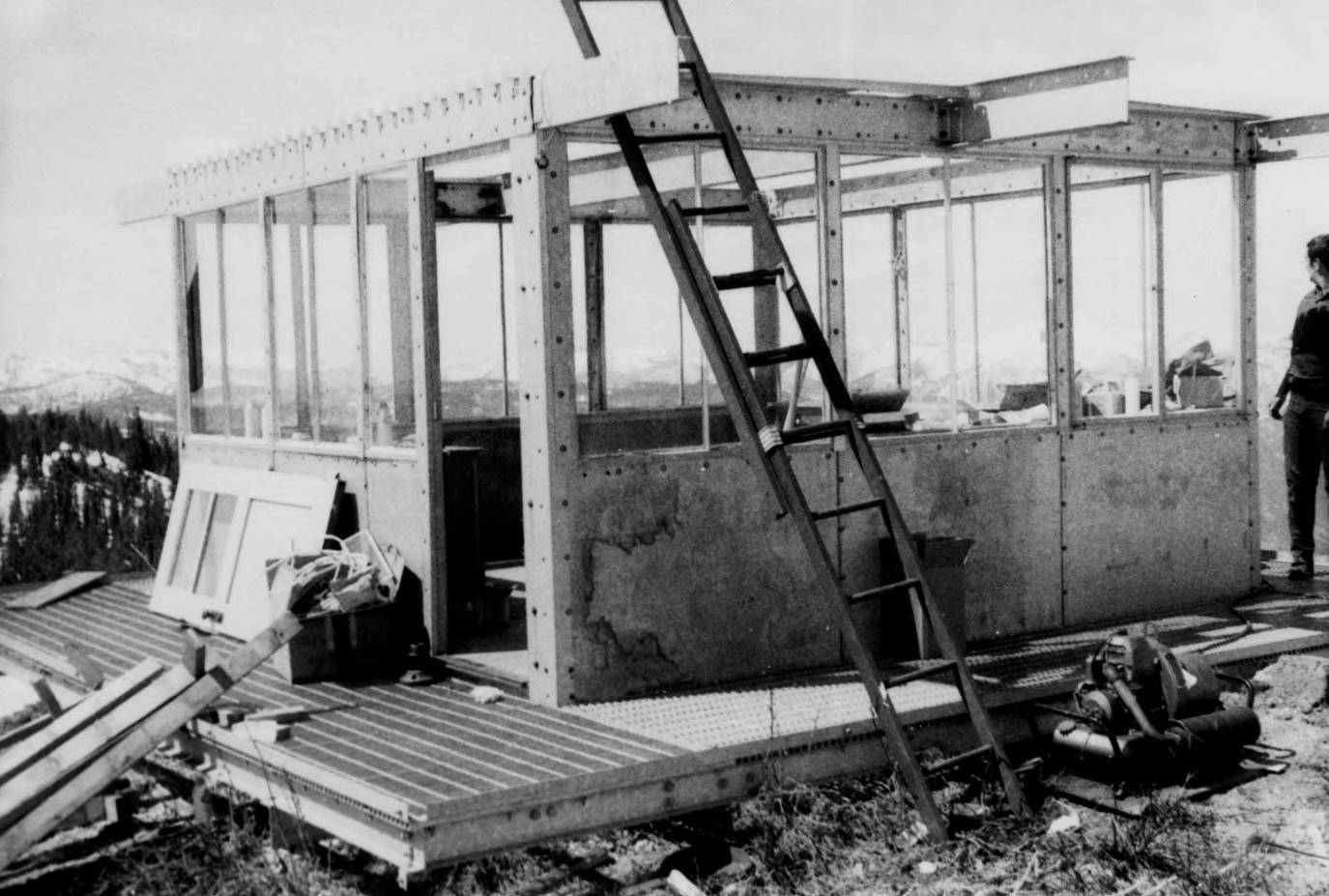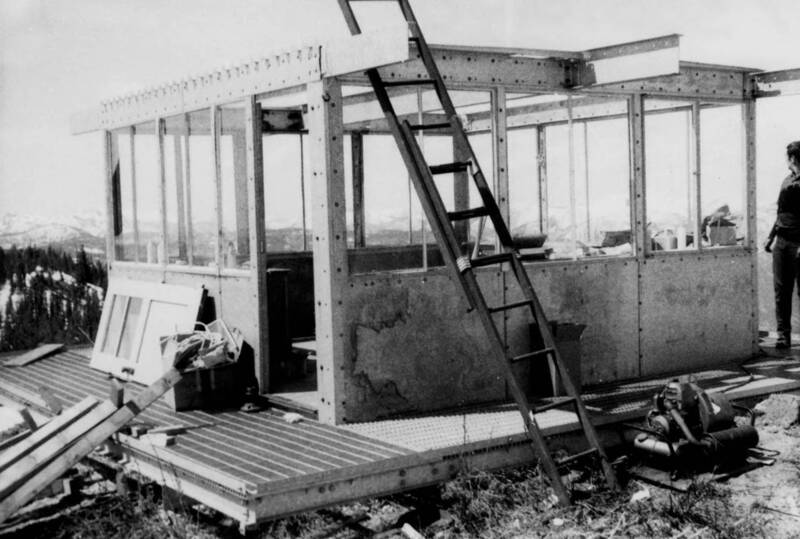Sheepeater Mountain Lookout
Built: 1934
Status: Staffed (only during peak fire sesaon)
Cabin: R-6
R-6

This cabin is a 15x15 foot design with a flat roof that extends over the deck to provide shade. Prior to its incorporation in 1953, the L-4 was the premier live-in cabin. R-6 cabins usually replaced L-4 cabins.
Other Resources:
National Lookout Historic Register
Rex's Fire Tower Page:
Photo Credit: University of Idaho Archival Idaho Photograph Collection
Sheepeater Mountain Lookout is located in the Frank Church River of No Return Wilderness and is staffed seasonally. This lookout is populated with interviews by Betsy Booth and Ed Allen. Betsy Booth has staffed lookouts in the Nez Perce National Forest and Frank Church River of No Return Wilderness. Ed Allen built, restored, and transported lookouts for the Forest Service. Watch clips and their full interviews for descriptions of the Native American history of Sheepeater Mountain, the role women have played in lookout history and culture, the struggles of staffing lookouts, and how lookouts are built and maintained.
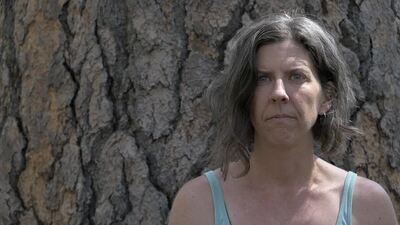
Sheepeater Mountain
-
Item 1 of 5
00:00:00:00 - 00:00:39:26
[Michael] So as we move away from fire lookouts, they kind of becomes, you know, obsolete in a way as new technologies is implemented. Do you feel like that transition away from the human staffed fire lookout, do you think anything is lost in that transition?
[Betsy] Yeah, absolutely. I mean, for one, it’s usually cheaper to staff a lookout for the summer than it is to put an aerial resource up.
00:00:39:28 - 00:01:16:18
[Betsy] Um, whenever you’ve had a lightning bust. So that’s kind of a thing. Um, that it’s a, uh, it’s a shift in, um, how budgets can be, you know, kind of sold, I guess, um. And it also you lose all of that human como, um, between the person who’s there all of the time versus the people, maybe the resources who just responded to a fire or some jumpers who aren’t from this forest, who got chucked out, and they need an idea of how to hike out best.
00:01:16:21 - 00:01:41:04
[Betsy] You know, and you can give them real time on the ground experience of where, you know, knowledge of where they should maybe head. Um, that weather watching, uh, you know, the fact that the cameras in particular, you know, will catch smoke and they’re getting better at it, but generally it’s not nearly as little smoke as the lookouts going to notice, um, in their day of watching out there.
00:01:41:04 - 00:02:05:10
[Betsy] And, uh, you wind up with bigger fires generally before the cameras pick them up than the human one, because it takes kind of a lot of smoke. Like if it’s if it’s at the time when, uh, when to look at when a camera can see it, it’s usually beyond a spot, unless it’s in some really unusual timber or something like that.
00:02:05:12 - 00:02:28:18
[Betsy] Yeah. And also lookouts track the lightning where it came in the first place. So, you know, like you’re looking for smoke to arise for weeks afterward in these spots that lightning hit. So you just kind of have a little bit of advance knowledge on things. I think that loses a lot. [Michael] So thinking about the spaces that fire towers are in.
00:02:28:22 - 00:03:00:29
[Betsy] Mm hmm.
[Michael] Do you think there’s a relationship between the fire lookout and wilderness?
[Betsy] Um. Ask that again. Sure.
[Michael] Yeah. Um, do you think that the. The concept of wilderness in Idaho as a as a wild space that sort of as free from human interference as possible. Do you think that there’s any sort of relationship between the reality of wilderness and what the fire lookout is?
00:03:01:02 - 00:03:29:22
[Betsy] Sure. Like just a, uh, a disconnect between the two things or connect either way.
[Michael] Um, yeah!
[Betsy] Um, well, the first thing comes to mind is like, you know, um, here in Idaho, we have the largest, you know, we have the Frank Church and then the 50 yard corridor between it with the Magruder road, you know, um, and then the Selway-Bitterroot and then the, uh, what you call it, Gospel Hump is just right there.
00:03:29:22 - 00:04:00:24
[Betsy] Off to the side, separated by a few dozen miles. Um, but all of those have airstrips grandfathered into them, right? So. And private and inholdings that are still in the centers of them. And so as far as like humans and structures on the ground that, um, don’t fit the wilderness. Um, uh, you know, structure as it’s written and everything like that.
00:04:00:26 - 00:04:31:02
[Betsy] There are already a lot of exceptions here, but I think they’re a little more truthful maybe than, um. I don’t know. I think humans, humans kind of should be out there a little bit. Humans would be out there if we hadn’t chased the Tukudeka, you know, out of out of, uh, The Church and, um, blah, blah, blah. You know, the, the, the history there is that people were on the ground, you know, since the late 1800s, to which in Idaho terms is ancient history.
00:04:31:05 - 00:05:11:28
[Betsy] Um, look out started being up there in the early 1900s. So as far as West Coast history, they kind of belong, um, and uh, but yeah, they’re, they’re an exception. You know, my, um, all of my lookouts had, uh, solar panels, so I, you know, I had propane stove, propane or solar fridge. Um, I had, uh, the ability to hook, um, my iPod and my coffee grinder into, into the battery bank and, uh, you know, and kind of live it up.
00:05:11:28 - 00:05:38:14
[Betsy] I had ice cubes at most of my lookouts because, again, the, you know, the refrigeration that I had available to myself, um, that’s kind of crazy. And totally different. And, you know, of course, what it was for decades and decades and decades, I had enough, um, just enough phone service that I could text and even make phone calls, you know, to the outside, uh, friends and family, instead of just being confined to the radio or the crank telephone.
00:05:38:17 - 00:06:02:26
[Betsy] Um, it’s, it’s, it’s a whole different deal than it used to be, but I think it still just kind of fits the other thing as well here, Krassel only has Sheepeater. I mean, the Payette only has Sheepeater left as a lookout. You’re left as a wilderness lookout. Um, salmon-Challis has a couple. Uh, I guess the as the Clear-Nez has a few.
00:06:02:26 - 00:06:22:26
[Betsy] Right. Kind of sprinkled in. Um, but so many more of them are more front country lookouts or outside of the wilderness, um, than we used to be. I guess I really wandered around a lot there. I’m not sure I answered any kind of question, but it was kind of funny question too, and I didn’t know where to go with it, so.
- Title:
- Native American Presence and an "Awareness"
- Date Created:
- 2021-06-17
- Description:
- Betsy Booth on Sheepeater Mountain and its indigenous history
- Subjects:
- Sheepeater Mountain Tukudika Lightning storms Frank Church River of No Return Wilderness Staffed Lookouts R-6 Gary Snyder Beatnicks
- Location:
- Frank Church River of No Return Wilderness
- Latitude:
- 45.38986
- Longitude:
- -115.34687
- Type:
- image;MovingImage
- Format:
- video/mp4
- Preferred Citation:
- "Native American Presence and an "Awareness"", Keeping Watch, Center for Digital Inquiry and Learning
- Reference Link:
- https://cdil.lib.uidaho.edu/keeping-watch/items/sheepeater-mountain.html#sheepeater-mountain001
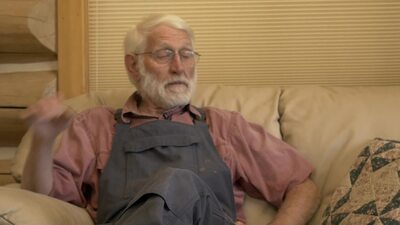
Sheepeater Mountain
-
Item 2 of 5
00:00:00:00 - 00:00:52:00
[Michael] If you could describe the view from Sheep Eater.
[Ed] Well, that is definitely has changed over time since our first experience with Sheepeater. But yeah, Sheepeater’s like around 8000, 8500 or something like that elevation and it’s you’re looking out from if looking out to the east off of it you know you see looking down at Sheepeater Lake and then falling a little bit to the north there’s Flossie Lake and in the early days when I was there, of course, the fire was to us almost like it’s kind of a wasn’t a stranger, but we didn’t have, you know, huge burned areas.
00:00:52:00 - 00:01:29:03
[Ed] So it was pretty much a mature timber area of all the lodgepole spruces and spruce sub Alpine for habitat and had a lot of it was always a place for, you know, people to go visit in that area. If you look in Chamberlain area, there’s kind of a rolling hills kind of lodgepole. So pretty typical, I guess zone in the northern hemisphere, I guess they call it.
00:01:29:05 - 00:02:04:08
[Ed] But I can’t come up right now the type of term for it. But in a way, you have a lot of a lot of spruce lodgepole. And at that time, early days when I first went, there were days it was all timbered. It was just, you know, so usual, looking out over this huge timber rolling forest area to the And if you look down like, say over in the, the Sheepeater Lakes area and there’s all these beautiful little mountain lakes in there, but in all this country and has a lot of that mostly glacial.
00:02:04:10 - 00:02:35:03
[Ed]…marine lakes and then if you look farther to the east, of course you looking over into the cottonwood view called Meadows country and a couple of you know, little range of mountains between there in the Middle Fork of the Salmon area. And so in the shade or the expansive view if you look to the west, to the west you’s looking out over the South Fork of the Salmon River.
00:02:35:03 - 00:03:11:24
[Ed] So Sheepeater probably offers one of the biggest view areas in the backcountry that’s probably one of the reasons why it’s remained a lookout all these years. And when I first went to the district there in 1972, we had I think four active lookouts there was Rush Creek Arctic Point, one over towards Cold Meadows, having a hard time coming up the name right now a little bit later, and then Sheepeater.
00:03:11:26 - 00:03:43:19
[Ed] So about four or five lookouts four lookouts, I guess at that time. Now it’s dwindled away to one. I believe, Sheepeater, and of course, prior to that seemed to me like there was a couple of dozen of them, maybe back in the early days when we had smoke chasers. They call them. So basically climb a tree, you know, I could see how far down you could down and get your little pack and go, and that was before my day.
[Michael] So you’ve watched the landscape change over time?
00:03:43:19 - 00:04:07:21
[Ed] Oh yeah and so when you get into that the changes which I have kind of referred to. Now we get you go up there and look off of Sheepeater, you’re looking at miles and miles of burned over forest. Some of it’s been, you know, long enough now that it’s starting to come back. There’s last time I was in Chamberlain area and there seem to be a lot of regeneration.
00:04:07:21 - 00:04:45:07
[Ed] Some of the early fires, you know, 67, 68, ‘9, 10 in that area. And then the 94 was a big year. Well, that’s pushing 20 years now. I mean, it’s you know, there’s the new forest, you know, not like not like what I experienced from the first winter, but we’ve had our policies changed a little bit with fire in the wilderness, of course, you know, and we’re allowed most of the fires that start natural to burn naturally, if they can, with some monitoring and that sort of thing.
00:04:45:09 - 00:05:20:17
[Ed] But, you know, yeah, the landscape has changed that way. Last time I was there was my daughter here a couple of years ago and we did some hiking around Chamberlain and July. And you couldn’t find anything in shade to get under, you know, for quite a bit of the area that was in. So, yeah, you know, it’s changed and, and much different, all of the rocks and the lakes are still there and a little more visible now than there were in 1972.
- Title:
- The View from Sheepeater Mountain Lookout
- Date Created:
- 2021-06-18
- Description:
- Ed Allen gives description of the view from Sheepeater Mountain Lookout and talks about the ways that fire policy has shaped that view over the years.
- Subjects:
- Sheepeater Mountain Tukudika Lightning storms Frank Church River of No Return Wilderness Staffed Lookouts R-6
- Location:
- Frank Church River of No Return Wilderness
- Latitude:
- 45.38986
- Longitude:
- -115.34687
- Type:
- image;MovingImage
- Format:
- video/mp4
- Preferred Citation:
- "The View from Sheepeater Mountain Lookout", Keeping Watch, Center for Digital Inquiry and Learning
- Reference Link:
- https://cdil.lib.uidaho.edu/keeping-watch/items/sheepeater-mountain.html#sheepeater-mountain002

Sheepeater Mountain
-
Item 3 of 5
- Title:
- Betsy Booth - Full Interview
- Date Created:
- 2021-06-17
- Description:
- Full interview of Betsy Booth
- Subjects:
- Sheepeater Mountain Tukudika Lightning Frank Church River of No Return Wilderness Staffed Lookouts R-6 wilderness act of 1964 systematic observation seen area lightning stool lightning rod
- Location:
- Frank Church River of No Return Wilderness
- Latitude:
- 45.38986
- Longitude:
- -115.34687
- Type:
- image;MovingImage
- Format:
- video/youtube
- Preferred Citation:
- "Betsy Booth - Full Interview", Keeping Watch, Center for Digital Inquiry and Learning
- Reference Link:
- https://cdil.lib.uidaho.edu/keeping-watch/items/sheepeater-mountain.html#sheepeater-mountain003

Sheepeater Mountain
-
Item 4 of 5
- Title:
- Ed Allen - Full Interview
- Date Created:
- 2021-06-17
- Description:
- Full Interview of Ed Allen
- Subjects:
- Sheepeater Mountain Tukudika Lightning storms Frank Church River of No Return Wilderness Staffed Lookouts R-6
- Location:
- Frank Church River of No Return Wilderness
- Latitude:
- 45.38986
- Longitude:
- -115.34687
- Type:
- image;MovingImage
- Format:
- video/youtube
- Preferred Citation:
- "Ed Allen - Full Interview", Keeping Watch, Center for Digital Inquiry and Learning
- Reference Link:
- https://cdil.lib.uidaho.edu/keeping-watch/items/sheepeater-mountain.html#sheepeater-mountain004
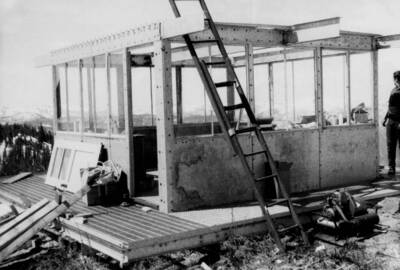
Sheepeater Mountain
-
Item 5 of 5
- Title:
- Early Photo Sheepeater Mountain Construction
- Date Created:
- 2021-08-23
- Description:
- Image of current Sheepeater lookout being constructed
- Subjects:
- Sheepeater Mountain Tukudika Lightning storms Frank Church River of No Return Wilderness Staffed Lookouts R-6
- Location:
- Frank Church River of No Return Wilderness
- Latitude:
- 45.38986
- Longitude:
- -115.34687
- Type:
- record
- Format:
- image/jpeg
- Preferred Citation:
- "Early Photo Sheepeater Mountain Construction", Keeping Watch, Center for Digital Inquiry and Learning
- Reference Link:
- https://cdil.lib.uidaho.edu/keeping-watch/items/sheepeater-mountain.html#sheepeater-mountain005

